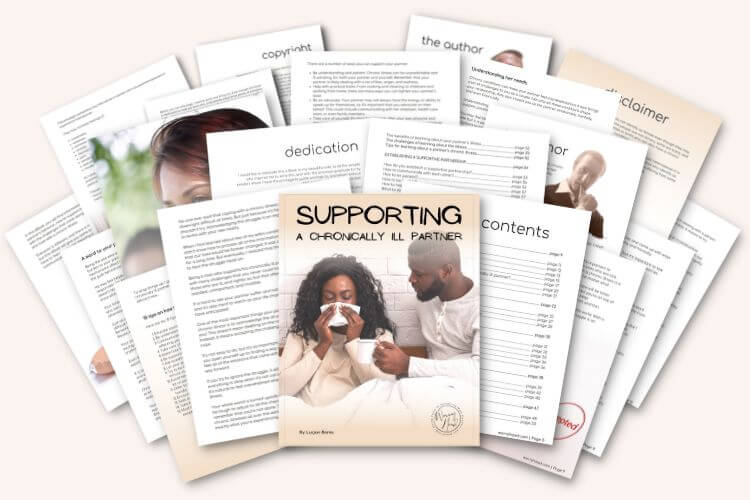How Relationship Goals Change with Chronic Illness?
When chronic pain pressed into our home, I learned love isn’t measured by grand fixes but by steady presence. How do relationship goals change when chronic illness becomes part of your everyday life?
Chronic illness reshapes goals from performance and timelines to health-first priorities: stable routines, honest communication, energy pacing, flexible work, financial planning, accessible home design, intimacy redefined, and shared care plans, aimed at stability, dignity, and connection. Daily.
That shift is practical and tender at once. Living with endometriosis, fibromyalgia, chronic fatigue, and the mental health impact of anxiety and depression with OCD symptoms, we chose smaller, kinder targets and protected energy like treasure.
You deserve a healthy relationship that adapts to this new normal without losing intimacy or hope.
Want help mapping that change? Grab a FREE chapter of my eBook and join our community. You will additionally get freebies, big discounts on our books, and real emails that help couples adjust to the new normal chronic illness brings into love and daily life. The first chapter alone contains a lot of information for both of you about acknowledging the struggles, including:
- A word to your partner.
- A word to you.
- Stepping on eggshells.
- Understanding her needs.
- How to acknowledge having a chronically ill partner?
- Acknowledging can be hard.
- 15 tips on how to do it!
Get the 1st Chapter FREE!
Chronic Illness for Partners

Living and Shaping Relationship Goals
The calendar had to flex around pain, not the other way, and I learned to count love in presence, not productivity. Clinic waiting rooms taught me more about relationship psychology than any book, and in marriage we adjusted expectations to protect the fragile hours after endometriosis flares.
When fibromyalgia and chronic fatigue steal a morning, we treat rest as productive, not a failure. That shift moved us toward a healthy relationship built on pacing and consent. The emotional impact of anxiety and depression means plans are invitations, never demands, and that small kindness keeps trust steady.
I had to unlearn the myth that love fixes chronic disease; love accompanies it closely and quietly. Invisible illness reshapes household roles with a gravity you only notice when you carry laundry up the stairs alone. Relationship lessons arrived through the stages of accepting chronic illness: denial, anger, grief, then a living acceptance that changes week to week.
We built routines around symptom tracking, nutrition, and gentle movement, reviewing them together like teammates. Financial planning became care planning because stability soothes the nervous system and lowers stress. Intimacy needed gentleness, humor, and timing that respects limits so touch feels safe again.
Practically, we keep medical notes in one place and agree on signals for “I’m at my edge.” Spiritually, we guard hope by celebrating tiny wins and allowing tears when pain spikes, because honesty keeps us close even when energy is scarce.
In this season, our relationship goals appear less like milestones and more like daily alignments. What matters is safety, truth, and choosing each other again in small, repeatable ways that let love breathe inside the new normal.
I still remember holding her hand after a brutal flare, promising I would learn a better way to show up, and meaning it with my whole life. If that memory makes your chest ache, you’re not alone; we are many, learning to love inside chronic illness with humility.
Next, I’ll share practical, life-anchored steps we use each week, simple, repeatable, and gentle, so you can shape love that lasts inside this reality.
- Build energy first in daily routines.
- Create gentle communication check-ins.
- Redesign roles with flexible pacing.
- Protect intimacy with pain-aware timing.
- Turn finances into stability plans.
- Simplify the home for flare accessibility.
- Co-manage care with shared notes.
- Anchor daily hope in micro wins.

Build Energy-First Daily Routines
Mornings changed when I stopped treating them like a race and started listening to her pain scale. We build the day from the ground up: hydration, gentle stretching, symptom check, meds, then food that doesn’t trigger endometriosis or fibromyalgia flares. Energy is a budget; we plan it like rent.
On better days, we add short walks, on tougher days we keep it quiet and protect the nervous system. Predictable anchors reduce anxiety and depression, and predictability is intimacy in disguise. When the routine holds, we both relax, because consistency tells the body and the heart, you’re safe here, and you don’t have to fight your home.
Gentle Communication Check-Ins
We do small, frequent check-ins instead of heavy talks that drain energy. A simple “Where are you, 1–10?” lets me respond to chronic pain without her having to compose a speech. I keep my tone soft, ask one question at a time, and accept short answers as complete.
When the invisible illness makes her quiet, I name it kindly and invite a pause. We avoid problem-solving at peak pain, saving decisions for calmer windows. Communication becomes care when we measure our words by how easy they are to receive, not by how clever they sound.
Redesign Roles with Flexible Pacing
Household roles aren’t fixed; they bend with symptoms. On bad weeks, I add the tasks that ignite flares like groceries, laundry, meals, while she conserves strength for recovery. On gentler weeks, she chooses light jobs that bring dignity without pushing past the edge.
We treat capacity like weather, not character. Flex charts on the fridge keep resentment low and clarity high. Relationship dynamics improve when roles are a living document, updated with honesty, and no one is punished for being human in the face of chronic disease.
Protect Intimacy, Pain-Aware Timing
We had to relearn closeness with consent as the compass and timing as the map. Pain-aware intimacy means warmth first, pressure never, and creative ways to be close that don’t spike symptoms. We slow down, check in, and use comfort items to help the body feel safe.
On flare days, intimacy is a forehead kiss, a heated blanket, and quiet laughter. On softer days, we go gently and stop at the first hint of strain. The goal is trust, not performance, so love can breathe even when endometriosis or fibromyalgia complicate touch.
Turn Finances Into Stability Plans
Money stress worsens symptoms, so we treat budgeting as health care. We map fixed costs, medical bills, and buffers for the unexpected, choosing predictability over pride. Work-from-home options protect energy and keep income steady during flare seasons.
We plan small sinking funds for meds, therapy, and equipment that ease daily life. When the numbers are calm, the nervous system is calmer too. Stability is romantic in a marriage like ours because it buys gentleness, options, and the freedom to heal without panic.
Simplify Home for Flare Accessibility
We design rooms to reduce effort: resting chairs where she needs them, soft lighting for migraines, and storage at reachable heights. Walkways stay clear so hard days don’t turn into hazards. The bedroom becomes a sanctuary, not a recovery ward.
Tools help pill organizers, grab-and-go snack baskets, and heat pads in easy drawers. Fewer decisions mean fewer stress spikes. A simplified home isn’t sterile; it’s soothing. It tells the body it can drop its guard, and that message eases both pain and anxiety.
Co-Manage Care with Shared Notes
We keep one shared notebook and a simple digital log: meds, triggers, questions for doctors, and patterns we spot over time. I attend appointments, not to speak over her, but to witness and remember. Two minds catch more, and advocacy is easier when we’re aligned.
We prepare concise updates for clinicians so visits stay focused and respectful. Tracking isn’t about control; it’s about clarity and compassion. When the map is clear, the journey feels less frightening, and that steadiness strengthens our marriage.
Anchor Hope in Daily Micro Wins
Hope grows in small places: a shower taken without dizziness, a meal that didn’t backfire, five minutes of sunlight. We celebrate these without sarcasm, because they are not small to a chronically ill body. Gratitude doesn’t erase grief; it keeps it from swallowing the day.
We keep a tiny list on the fridge and read it on the hard nights. Progress isn’t linear, but noticing it is. Micro wins train the mind to see life beyond symptoms, and that vision keeps us moving, hand in hand, through the new normal.

Conclusion on How Relationship Goals Change with Chronic Illness
What began as a love story shaped by plans and timelines has become a love story shaped by presence, patience, and daily redesign. Chronic illness did not ask permission to enter our marriage. It arrived with pain, fatigue, and the mental weight of anxiety and depression, and it asked us who we were willing to become for each other.
We learned that safety is the first form of intimacy. A calm room, a soft light, and a partner who listens can quiet a nervous system on high alert. When the body is believed, the heart opens. That is relationship psychology lived out in a kitchen at 2 a.m., whispering through a flare.
We shifted from performance to pacing. Healthy relationship habits look different when endometriosis and fibromyalgia set the rhythm. Wins are smaller but far truer. A shower without dizziness, a meal that sits well, a laugh that breaks through the cloud. These are not compromises. They are anchors.
Role flexibility rescued us from resentment. The laundry, the meals, the appointment notes, and the advocacy at clinics are not points to tally. There are ways to love on the days when touch must be gentler. We keep our plans light and our honesty heavy, so neither of us carries more than we should.
Acceptance did not come once. It visits in stages. Some days we grieve what chronic disease changed. Some days we feel strong and inventive, building a home that is kinder to her body. The grief does not cancel the hope. They hold hands and walk with us.
Finances became part of care. Predictable budgets lower stress. Work from home options protect energy. Stability is not about control. It is about coating life with enough calm that healing has room to try. The simplest routines can feel like mercy.
Care is a team sport. Shared notes, short check-ins, and clear signals keep us aligned when symptoms move the goalposts. We ask fewer questions and offer more presence. We solve less during pain and plan more during calm. This is relationship advice I live, not theory I repeat.
Hope is practical. It is the list on the fridge, the plan for tomorrow’s breakfast, the promise that we will stop at the first sign of strain. It is the choice to celebrate micro wins without apologizing for their size. It is the courage to try again after a setback.
If you are living with chronic pain, fatigue, or an invisible illness, you are not hard to love. You are carrying a heavy thing and still choosing tenderness. I believe in the future you are building. Not a perfect one. A human one. One shaped by trust, gentleness, and patient care.
In that future, relationship goals serve your life, not the other way around. Let love be measured by presence, not performance. Let small steps count. Let today be enough.
You can build a steady, tender partnership inside chronic illness by choosing safety, pacing, flexible roles, clear communication, simple routines, and practical hope. Small wins are real wins. Let your home soften the hard days and let love be the daily decision that steadies you both.
If this spoke to you, leave a comment and share your story on how your relationship goals change with chronic illness. And if you want gentle, practical guidance, grab the FREE chapter of my eBook and join our community for more support and bonuses.


About Me
Hi, I’m Lucjan! The reason why I decided to create this blog was my beautiful wife, who experienced a lot of pain in life, but also the lack of information about endometriosis and fibromyalgia for men…
READ MORE